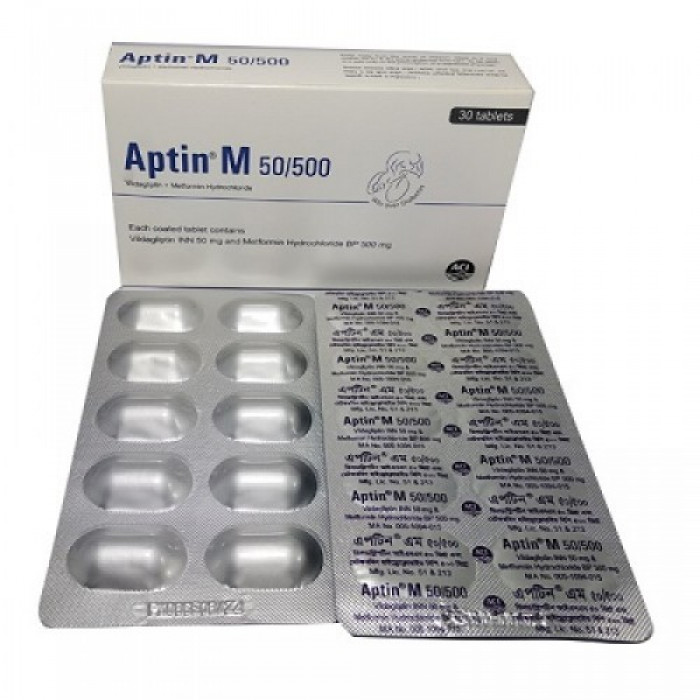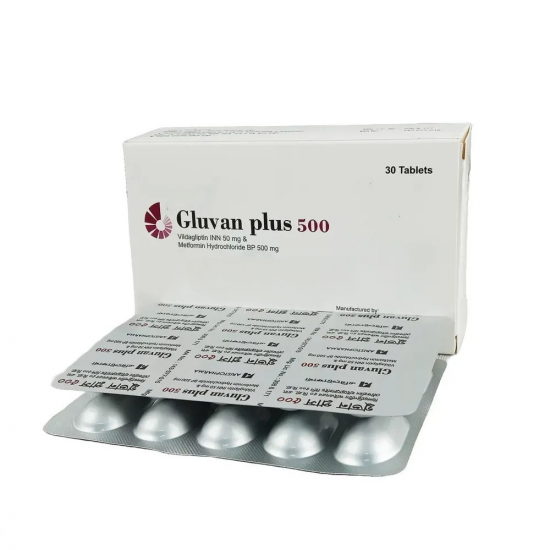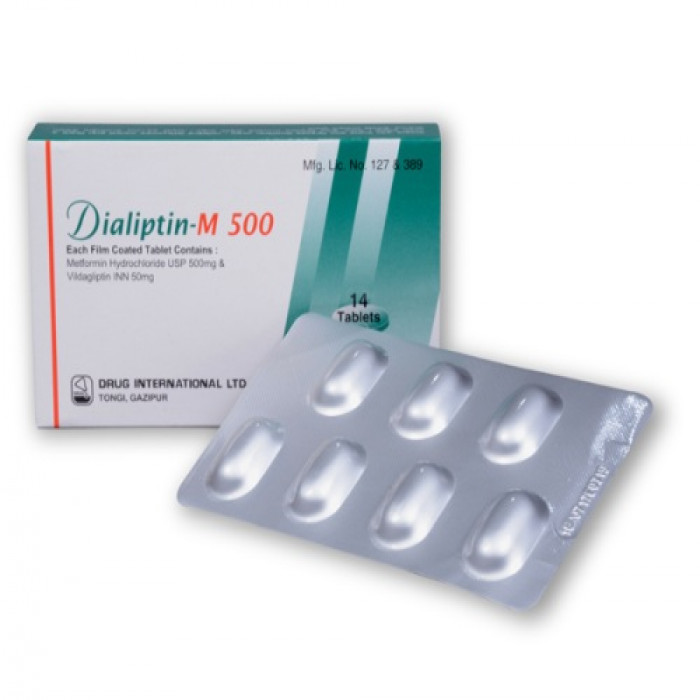
✔ 100% Authentic Product
👁️ Currently Viewing 2666
Vida Plus 500mg Tablet
Vildagliptin+Metformin Hydrochloride is prescribed for individuals with type 2 diabetes who are unable to effectively manage their condition with metformin hydrochloride or vildagliptin alone, or for those who have already used a combination of vildagliptin and metformin hydrochloride. It is used in conjunction with diet and exercise to enhance blood sugar control.
Discount
Price: ৳ 62
MRP:
৳
66
6%
Off

100% Genuine Products, Guaranteed

Safe & Secure Payments, Always

Fast, Secure & Efficient Delivery

Proper Packaging
 Cash on Delivery - All over Bangladesh
Cash on Delivery - All over Bangladesh Regular Delivery - 12-24 Hours, Dhaka City* Charge Tk.39-59
Regular Delivery - 12-24 Hours, Dhaka City* Charge Tk.39-59 Regular Delivery - 24-48 Hours, Other Cities* Charge Tk.99-110
Regular Delivery - 24-48 Hours, Other Cities* Charge Tk.99-110
 ফ্রি ডেলিভারিঃ - ৯৯৯ টাকা+ অর্ডারে, ঢাকা
শহরে
ফ্রি ডেলিভারিঃ - ৯৯৯ টাকা+ অর্ডারে, ঢাকা
শহরে ফ্রি ডেলিভারিঃ - ২৯৯৯ টাকা+ অর্ডারে, ঢাকার
বাহিরে
ফ্রি ডেলিভারিঃ - ২৯৯৯ টাকা+ অর্ডারে, ঢাকার
বাহিরে
100% Genuine Products, Guaranteed
Safe & Secure Payments, Always
Fast, Secure & Efficient Delivery
Proper Packaging
 Cash on Delivery - All over Bangladesh
Cash on Delivery - All over Bangladesh Regular Delivery - 12-24 Hours, Dhaka City* Charge Tk.39-59
Regular Delivery - 12-24 Hours, Dhaka City* Charge Tk.39-59 Regular Delivery - 24-48 Hours, Other Cities* Charge Tk.99-110
Regular Delivery - 24-48 Hours, Other Cities* Charge Tk.99-110 ফ্রি ডেলিভারিঃ - ৯৯৯ টাকা+ অর্ডারে, ঢাকা
শহরে
ফ্রি ডেলিভারিঃ - ৯৯৯ টাকা+ অর্ডারে, ঢাকা
শহরে ফ্রি ডেলিভারিঃ - ২৯৯৯ টাকা+ অর্ডারে, ঢাকার
বাহিরে
ফ্রি ডেলিভারিঃ - ২৯৯৯ টাকা+ অর্ডারে, ঢাকার
বাহিরে
✅ Description:
Vida Plus 500mg Tablets is a combination medication that includes Vildagliptin (a DPP-4 inhibitor) and Metformin (a Biguanide). It is classified as an anti-diabetic drug used to manage Type 2 diabetes mellitus, which was previously referred to as 'non-insulin-dependent diabetes mellitus (NIDDM)' or 'maturity-onset diabetes.' Type 2 diabetes develops when the body doesn't produce enough insulin or when the body's insulin doesn't function effectively. It can also occur if the body produces excessive glucagon. Insulin is crucial for lowering blood sugar levels, particularly after meals, while glucagon prompts the liver to produce sugar, causing blood sugar levels to rise. Both of these substances are produced by the pancreas.
Vida Plus 500mg Tablet helps regulate blood sugar levels by promoting insulin production and reducing glucagon production (the effect of vildagliptin). It also enhances the body's utilization of available insulin (the effect of metformin). However, it's important to continue following the dietary and exercise recommendations provided while taking Vida Plus 500mg Tablet. This medication is not a replacement for insulin and is not used to treat Type 1 diabetes (where the body doesn't produce insulin) or diabetic ketoacidosis.
To avoid stomach discomfort, Vida Plus 500mg Tablet should be taken with food. It should be taken at the same time each day for optimal results. Your doctor will determine the appropriate dosage, which may change rapidly based on your condition. The most common side effect is hypoglycemia (low blood sugar), which can manifest as dizziness, sweating, palpitations, hunger, dry mouth, and skin, among other symptoms. To prevent hypoglycemia, it's essential not to skip meals and to have a source of sugar on hand. Other side effects may include alterations in taste, nausea, diarrhea, stomach discomfort, headache, and upper respiratory symptoms.
It's crucial not to discontinue the Vida Plus 500mg Tablet without consulting your doctor, even if you start feeling better, as blood sugar levels can fluctuate. Abruptly stopping this medication may lead to elevated sugar levels, increasing the risk of complications such as retinopathy (vision loss), nephropathy (kidney problems), and neuropathy (nerve damage). Vida Plus 500mg Tablet should not be used if you have Type 1 diabetes or severe kidney or liver disease. Inform your doctor if you have any heart conditions or if you are planning to become pregnant or breastfeed.
Safety Advices

Alcohol
UNSAFE
Consumption of alcohol is not recommended during treatment with Vida Plus 500mg Tablet since it may increase the risk of lactic acidosis

Pregnancy
CONSULT YOUR DOCTOR
Vida Plus 500mg Tablet is generally not recommended for use in pregnant women unless it is considered clearly necessary. Consult your doctor before taking Vida Plus 500mg Tablet.

Breastfeeding
CONSULT YOUR DOCTOR
Vida Plus 500mg Tablet is not recommended for use in breastfeeding women. Consult your doctor before taking Vida Plus 500mg Tablet.

Driving
UNSAFE
Do not drive or operate any machines if you experience dizziness after taking Vida Plus 500mg Tablet.

Kidney
CONSULT YOUR DOCTOR
Vida Plus 500mg Tablet is not recommended in patients with severely reduced kidney function. Consult your doctor before taking Vida Plus 500mg Tablet.

Liver
CONSULT YOUR DOCTOR
Vida Plus 500mg Tablet is not recommended in patients with liver disease. Consult your doctor before taking Vida Plus 500mg Tablet.
✔️ Uses of Vida Plus 500mg Tablet
- Type 2 Diabetes Mellitus
✔️ How does Vida Plus 500mg Tablet work?
Metformin + Vildagliptin is a combination of two antidiabetic medications: Metformin and Vildagliptin. Metformin is a biguanide that reduces liver glucose production, slows glucose absorption from the intestines, and enhances insulin sensitivity. Vildagliptin, a DPP-4 inhibitor, boosts insulin release from the pancreas and reduces blood sugar-raising hormones, effectively lowering both fasting and post-meal sugar levels. Together, they offer improved blood sugar control.
✔️ Side Effects of Vida Plus 500mg Tablet
Common side effects may include headache, tremors, dizziness, nausea, and hypoglycemia.
✔️ Quick Suggestions:
- You have been prescribed this combination medicine as it can control blood sugar better than metformin alone.
- Take it in addition to regular exercise and a healthy diet to lower levels of blood sugar.
- Take it with food to lower your chance of having an upset stomach.
- Chances of weight gain and low blood sugar are lesser as compared to other diabetes medicines.
- Inform your doctor about your diabetes treatment if you are due to have surgery under a general anesthetic.
- Tell your doctor immediately if you experience any deep or rapid breathing, persistent nausea, vomiting, and stomach pain as Metformin + Vildagliptin may cause a rare but serious condition called lactic acidosis, which is an excess of lactic acid in the blood.
- Your doctor may check your kidney and liver function before starting treatment and regularly thereafter. Inform your doctor if you develop symptoms such as abdominal pain, fatigue, loss of appetite, darkened urine, or yellowing of the eyes or skin (jaundice).
✔️ Type 2 Diabetes
Type 2 Diabetes is a medical condition characterized by the body's inability to produce an adequate amount of insulin or the body's inability to effectively use the insulin it produces. This results in elevated blood sugar levels, a condition known as hyperglycemia. Common symptoms of type 2 diabetes include:
- Increased thirst: Individuals with type 2 diabetes often experience excessive thirst (polydipsia) as a result of high blood sugar levels.
- Frequent urination, especially at night: The need to urinate frequently, particularly during the nighttime, is a common symptom of diabetes, known as polyuria.
- Slow wound healing: High blood sugar levels can impair the body's ability to heal wounds and injuries promptly.
- Increased hunger: People with diabetes may feel hungry more frequently due to difficulties in utilizing glucose for energy.
- Fatigue: Persistent fatigue and low energy levels are common in individuals with untreated or poorly managed type 2 diabetes.
- Blurred vision: High blood sugar can affect the lens of the eye, leading to temporary blurred vision.
In some cases, individuals with type 2 diabetes may experience weight gain, while others may undergo weight loss, although the latter is relatively rare.
Type 2 diabetes can lead to various complications, including:
- Neuropathy: Nerve damage that can cause numbness, tingling, or pain in the extremities.
- Nephropathy: Kidney problems, which can progress to kidney failure if left untreated.
- Retinopathy: Damage to the retina of the eyes, potentially leading to vision impairment or blindness.
- Limb amputation: Severe diabetes-related complications can necessitate amputation of limbs.
- Sexual dysfunction: Diabetes can contribute to sexual problems in both men and women.
- Increased risk of heart attack or stroke: Uncontrolled diabetes significantly raises the risk of cardiovascular diseases.
Managing type 2 diabetes typically involves lifestyle modifications, such as dietary changes, regular physical activity, and weight management, in addition to medication or insulin therapy as prescribed by a healthcare provider. Regular monitoring of blood sugar levels and routine medical check-ups are essential to prevent and manage complications associated with type 2 diabetes.
✔️ Pharmacology
Vildagliptin primarily acts by inhibiting DPP4 (dipeptidyl peptidase 4), an enzyme responsible for breaking down incretin hormones such as GLP1 (glucagon-like peptide 1) and GIP (glucose-dependent insulin-promoting polypeptide). By blocking DPP4, vildagliptin elevates the levels of these incretin hormones, which, in turn, boosts insulin secretion from pancreatic β cells and reduces glucagon secretion from α cells. This hormonal balance results in reduced hepatic glucose production and, consequently, lower blood sugar levels.
Metformin hydrochloride, a biguanide oral hypoglycemic agent, further complements this action. It lowers both baseline and post-meal blood sugar levels by reducing hepatic glucose production, decreasing intestinal glucose absorption, and enhancing insulin sensitivity through increased peripheral glucose uptake and utilization.
✔️ Dosage & Administration of Vida Plus 500mg Tablet
For adults, the recommended dose depends on the current metformin dose. Typically, it is taken twice daily with one tablet in the morning and one in the evening. Patients previously taking vildagliptin and metformin as separate tablets can transition to this combination, with the dosage of each component remaining the same. It is not advisable to exceed a vildagliptin dose of 100 mg. Limited clinical experience exists regarding combining vildagliptin and metformin with other hypoglycemic agents. Taking this combination with or after meals can help reduce gastrointestinal side effects linked to metformin.
✔️ Interaction
When vildagliptin (100 mg once daily) is co-administered with metformin hydrochloride (1,000 mg once daily), no clinically significant pharmacokinetic interactions have been observed. Vildagliptin's potential for drug interactions is minimal since it does not interact with cytochrome P (CYP) 450 enzymes and is neither a substrate for nor an inhibitor or inducer of these enzymes. Studies have shown no significant interactions when co-administered with other oral hypoglycemic drugs, amlodipine, digoxin, ramipril, simvastatin, valsartan, or warfarin. However, it does interact with furosemide, nifedipine, and glibenclamide, increasing the blood levels of metformin without affecting its renal clearance.
✔️ Contraindications
This combination is contraindicated in individuals with known allergies to vildagliptin, metformin hydrochloride, or any of its components. Contraindications also include patients with kidney disease or failure, acute myocardial infarction, sepsis, congestive heart failure, acute or chronic metabolic acidosis (including diabetic ketoacidosis), and those receiving intravascular iodine-containing contrast agents for radiological studies.
✔️ Pregnancy & Lactation
There is insufficient data from well-controlled studies involving pregnant women, so the use of this combination during pregnancy should be justified only if the potential benefits outweigh the risks to the fetus. The excretion of vildagliptin and/or metformin hydrochloride in breast milk is not well-established; therefore, breastfeeding women are advised not to use this combination.
✔️ Precautions & Warnings
Patients taking this medication should be monitored for the development of lactic acidosis, particularly those with kidney dysfunction or who are elderly. Serum creatinine should be checked annually for patients with normal kidney function and more frequently for those with elevated levels or the elderly. Caution is advised when using this medication in elderly patients, especially when initiating antihypertensives, diuretics, or non-steroidal anti-inflammatory drugs. Liver function tests (LFTs) should be conducted before starting the treatment, every three months during the first year, and regularly thereafter. If transaminase levels are elevated, a follow-up liver function assessment is recommended. If AST or ALT remains elevated at 3 times the upper limit of normal, discontinuation of vildagliptin and metformin tablets is advised. Patients exhibiting jaundice or other signs of liver dysfunction should not resume this treatment even if liver function returns to normal. Vildagliptin and metformin tablets should be discontinued 48 hours before elective surgery under general anesthesia and should not be resumed earlier than 48 hours post-surgery.
✔️ Storage Conditions
Store in a dry place away from light and heat, and keep it out of reach of children.
⚠️Disclaimer:
At ePharma, we’re committed to providing accurate and accessible health information. However, all content is intended for informational purposes only and should not replace medical advice from a qualified physician. Please consult your healthcare provider for personalized guidance. We aim to support, not substitute, the doctor-patient relationship.











